For time-lapse cell imaging, you’ll need controllers that maintain precise ±0.1°C stability. Top options include Precision Stage-Top Incubators with humidity control, High-Accuracy Digital Controllers with PT-100 sensors, and Compact Mini-Incubators with water jacket technology. Also consider Integrated Environmental Systems, Multi-Parameter Controllers, Microfluidic Platforms, AI-Enhanced Regulators, Portable Units, and Multi-Well Format systems. The right temperature controller guarantees natural cell behavior and prevents costly imaging artifacts.
Precision Stage-Top Incubators With Advanced Temperature Regulation
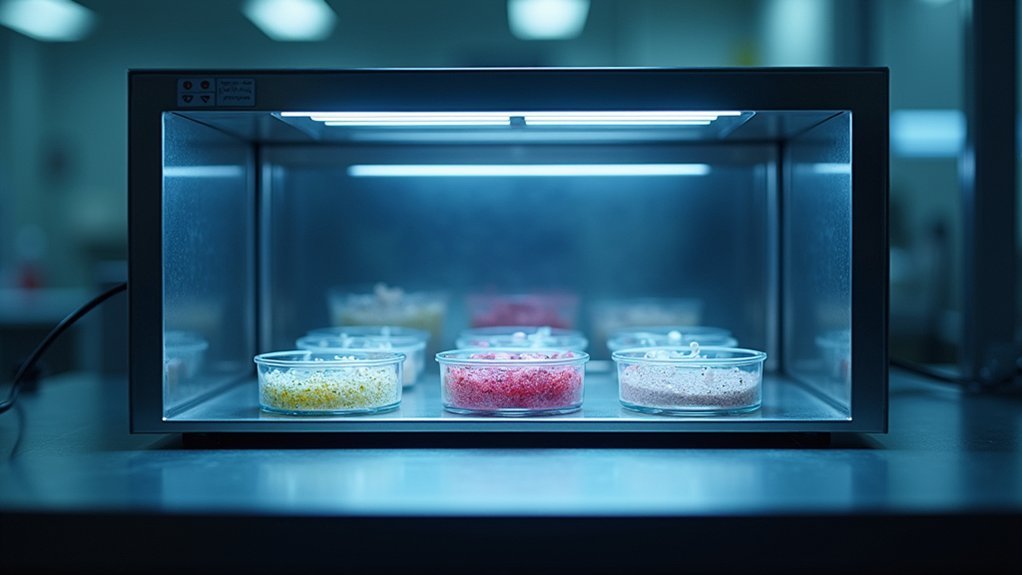
When conducting time-lapse cell imaging, precision stage-top incubators serve as the cornerstone for reliable temperature control. Systems like the EVOS® Onstage Incubator maintain exceptional ±0.1°C precision, ensuring ideal cell viability throughout your experiments.
Advanced models incorporate sophisticated temperature control mechanisms, including the Automatic Sensing Mode found in the Incubator T Series. You’ll appreciate how dual-layered glass covers provide critical temperature stability while maintaining humidity levels above 90% during extended imaging sessions.
For long-term live cell imaging with well plates, the Incubator TW (Wide) offers built-in water reservoirs that sustain proper humidity conditions.
These systems typically employ PT 100ohm and K-type thermocouple sensors to deliver the precise temperature regulation necessary for collecting accurate, reproducible time-lapse data from your living cell cultures.
Integrated Environmental Control Systems for Extended Time-Lapse Imaging
Because cellular processes often unfold over days rather than hours, integrated environmental control systems provide the thorough stability needed for extended time-lapse imaging.
The EVOS® Onstage Incubator exemplifies these control systems, maintaining temperature with ±0.1°C accuracy while sustaining humidity above 90%—essential conditions for viable mammalian cells during time-lapse microscopy.
Precise temperature control and high humidity maintenance form the backbone of successful time-lapse microscopy for mammalian cell studies.
For successful live-cell imaging experiments, you’ll benefit from:
- Programmable gas gradients that mimic in vivo conditions
- Real-time monitoring through user-friendly interfaces
- LED-based illumination to minimize phototoxicity during extended studies
- Versatile culture vessel accommodation for parallel experiments
These stable environmental conditions enable you to capture cellular dynamics accurately while preserving cell health, making integrated systems indispensable for researchers conducting multi-day time-lapse studies.
Compact Mini-Incubators With Water Jacket Circulation Technology
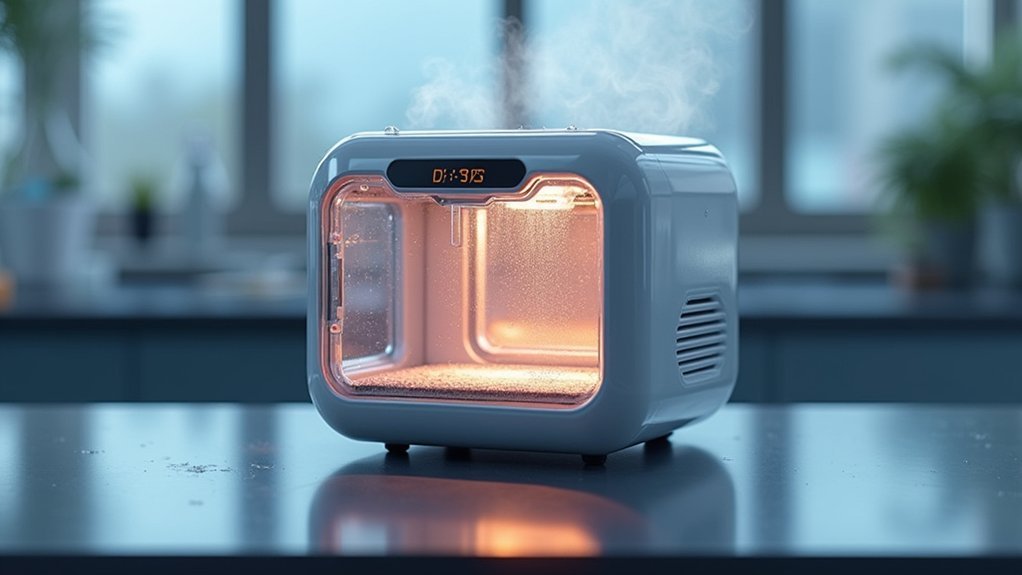
Compact mini-incubators with water jacket circulation offer superior temperature stability compared to standard air-heated systems, maintaining consistent 37°C conditions within ±0.1°C throughout your imaging experiments.
You’ll find that these water jackets create thermal inertia, effectively buffering against ambient temperature fluctuations that could compromise cell viability during long-term observations.
The continuous circulation of temperature-controlled water guarantees uniform heat distribution across all culture vessels, eliminating edge effects commonly experienced with direct heating methods.
Water Jacket Advantages
While several temperature control solutions exist for cell imaging, compact mini-incubators with water jacket circulation technology offer distinct advantages for time-lapse experiments.
You’ll find that water jacket systems provide superior temperature stability for maintaining human cell viability during extended imaging sessions.
- Precise temperature control within ±0.1°C guarantees consistent experimental conditions, critical for accurate time-lapse imaging results.
- Minimal thermal fluctuations prevent focus drift caused by thermal expansions or contractions, maintaining image quality throughout your experiment.
- Integrated humidity control via water reservoirs prevents medium evaporation, preserving physiological conditions.
- Compact design enables easy integration with inverted microscopes, allowing you to run parallel experiments efficiently without sacrificing environmental stability.
Temperature Stability Comparison
Having established the benefits of water jacket systems, let’s examine how these compact mini-incubators compare to alternative temperature control methods.
These systems demonstrate superior temperature stability at the critical 37°C threshold compared to direct heating methods. The microcontroller paired with PT-100 sensors delivers precise control, maintaining your cell culture medium within ±0.1°C even during extended live cell imaging sessions.
Unlike air-based systems that experience fluctuations during imaging, water jacket circulation recovers quickly after disturbances thanks to high-power parallel resistors.
This robust environmental control allows you to conduct multiple experiments simultaneously without compromising conditions. The specialized design prevents pH shifts and hyperosmolarity issues that plague less sophisticated setups, especially during time-lapse studies lasting days rather than hours.
High-Accuracy Digital Temperature Controllers With ±0.1°C Precision
High-accuracy digital temperature controllers with ±0.1°C precision help you eliminate temperature-induced image drift that can compromise your time-lapse data quality.
You’ll maintain stable physiological environments throughout extended imaging sessions, ensuring cells behave naturally under conditions that closely mimic their in vivo state.
These controllers’ exceptional precision allows you to reproduce experimental conditions reliably across multiple studies, enhancing the validity of your research outcomes.
Preventing Image Drift
Because consistent temperature is fundamental to successful time-lapse imaging, digital controllers with ±0.1°C precision have become essential laboratory equipment.
When you’re studying mammalian cells over hours or days, even minor temperature fluctuations can cause thermal expansion or contraction that leads to image drift, compromising your entire experiment.
Effective temperature control systems prevent focus instability by:
- Utilizing PT-100 temperature sensors for continuous, accurate monitoring
- Maintaining stable physiological conditions with minimal thermal variations
- Reducing mechanical drift through consistent temperature distribution
- Eliminating temperature-related artifacts that compromise data quality
Systems like the EVOS® Onstage Incubator and ThermoClamp® Inline Heater excel at preventing image drift during long-term imaging, ensuring your time-lapse experiments deliver reliable, publication-quality data without the frustration of temperature-induced focus problems.
Stable Physiological Environments
Three essential elements define successful time-lapse cell imaging: precision, stability, and reproducibility. High-accuracy digital temperature controllers with ±0.1°C precision are indispensable for maintaining these elements throughout extended experiments.
Systems like the EVOS® Onstage Incubator provide precise temperature control necessary for cell viability during prolonged imaging sessions. The integration of advanced Peltier devices with PID controllers effectively regulates thermal conditions in your microscopy setup.
For accurate temperature monitoring, controllers equipped with PT100 or K-type thermocouple sensors guarantee your cell culture media remains at ideal conditions.
Innovations such as the ThermoClamp® Inline Heater and Objective Heater System enhance live-cell imaging by maintaining consistent physiological environments.
These technologies not only improve experimental reproducibility but also preserve data integrity by eliminating temperature-induced artifacts in your imaging studies.
Multi-Parameter Controllers for Synchronized Temperature and CO₂ Regulation
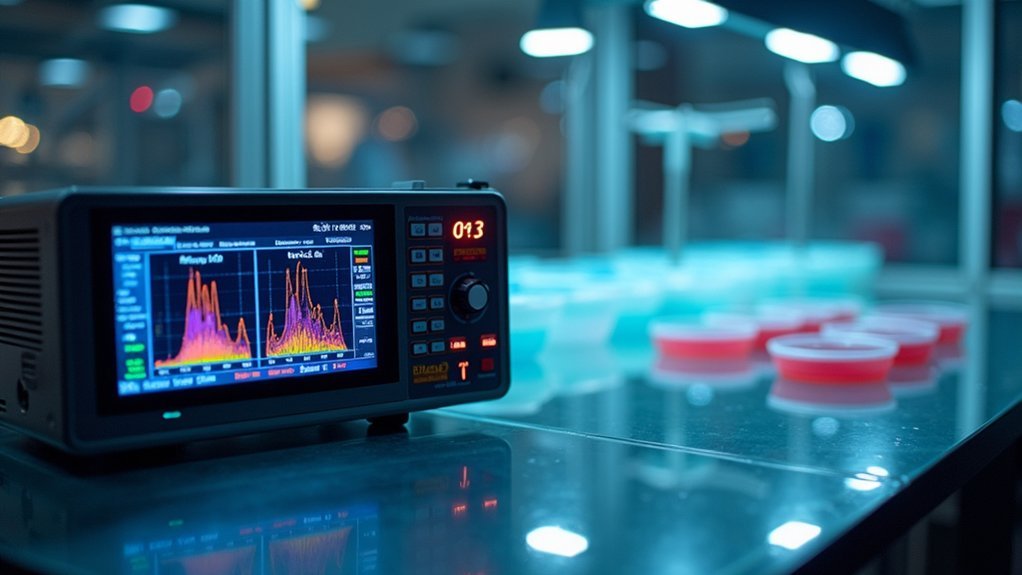
Successful time-lapse cell imaging depends critically on maintaining stable physiological conditions throughout extended observation periods. Multi-parameter controllers excel at synchronizing temperature regulation and gas concentrations, ensuring your live cells remain viable during time-lapse imaging sessions.
Stable physiological conditions are non-negotiable for time-lapse cell imaging success, where integrated control systems become your experimental lifeline.
Systems like the Incubator T Series maintain precise physiological environments with temperature accuracy of ±0.1°C while simultaneously managing CO₂ levels for ideal pH balance.
- Automatic sensing modes utilize varied heating feedback mechanisms for consistent temperature maintenance.
- Programmable gas gradients allow real-time CO₂ adjustments to prevent damaging fluctuations.
- Humidity control systems prevent media evaporation during extended imaging.
- Remote monitoring capabilities via touchscreens or mobile devices let you track conditions without disrupting experiments.
These integrated solutions eliminate the need for separate controllers, streamlining your workflow and improving experimental reproducibility.
LED-Compatible Temperature Systems for Reduced Phototoxicity
LED-compatible temperature systems offer you significant advantages by minimizing phototoxicity through reduced UV radiation exposure during extended time-lapse imaging sessions.
You’ll find these controllers incorporate specialized heat dissipation mechanisms that prevent thermal interference with imaging while maintaining cell viability within ±0.1°C of your target temperature.
When selecting a system for your research, look for models with integrated objective heaters that maintain immersion lens temperatures, ensuring consistent imaging quality throughout your experiments.
Low-Radiation LED Controllers
While traditional illumination sources can damage sensitive biological specimens during extended imaging periods, low-radiation LED controllers represent a significant advancement in time-lapse cell imaging technology.
You’ll find these systems essential for maintaining cell viability through reduced phototoxicity during live-cell imaging experiments.
- LED controllers minimize harmful UV exposure while providing sufficient fluorescence signal intensity for clear imaging
- Higher imaging speeds and lower light intensity preserve both cells and fluorophores during extended time-lapse studies
- Programmable temperature control settings guarantee physiological conditions remain stable throughout your experiments
- Integration with temperature systems creates a thorough environment that balances ideal imaging with cell health
Heat Dissipation Systems
Because cellular responses can be dramatically altered by even slight temperature fluctuations, effective heat dissipation systems represent a critical component in LED-compatible time-lapse imaging setups.
You’ll find that integrating Peltier devices with precision temperature controllers offers superior thermal management while minimizing fluctuations that could compromise your experimental results.
Solutions like Delta T® Culture Systems maintain ideal conditions while ensuring high-numeric aperture compatibility, giving you clear imaging without sacrificing cell viability.
When designing your setup, consider incorporating objective heaters to prevent thermal dissipation through optical coupling media. This approach maintains sample temperature stability while reducing phototoxicity risks.
For applications requiring rapid temperature adjustments, systems like the ThermoClamp® Inline Heater provide precise control from ambient to 65°C, protecting your samples from heat-related damage during extended imaging sessions.
Microfluidic Temperature Control Platforms for Single-Cell Analysis
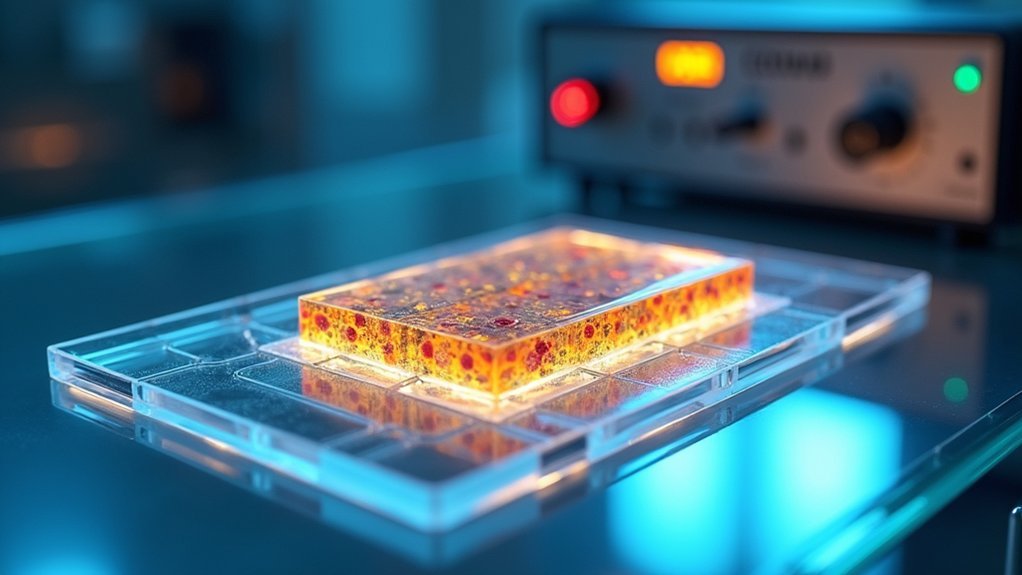
Precision stands at the heart of successful single-cell analysis, with microfluidic temperature control platforms offering unprecedented thermal stability for time-lapse imaging experiments.
These systems maintain conditions within ±0.1°C, ensuring ideal cell viability throughout your studies. Integrated Peltier devices provide rapid temperature adjustments needed to capture dynamic cellular responses in real-time.
- Enhanced experimental flexibility through customizable fluidic channels that adapt to your specific research requirements
- Reduced experimental artifacts by minimizing evaporation and osmotic shocks during extended imaging sessions
- Improved data reliability via continuous real-time monitoring and thermal feedback mechanisms
- Greater experimental control with integrated sensors that maintain precise microenvironmental conditions
You’ll find these platforms particularly valuable when studying temperature-sensitive cellular processes that require both stability and the ability to implement programmed temperature changes.
Ai-Enhanced Temperature Regulation Systems With Predictive Stabilization
Rather than just responding to thermal changes, Ai-enhanced temperature regulation systems anticipate fluctuations before they occur, revolutionizing time-lapse cell imaging.
These intelligent controllers deliver remarkable precision of ±0.1°C, essential for maintaining cell viability during extended observation periods.
You’ll benefit from real-time monitoring capabilities that continuously adjust heating and cooling elements in response to environmental shifts, minimizing cellular stress.
Advanced models integrate automated humidity management and gas control features, creating thorough microenvironments for sensitive cultures.
Portable Temperature Control Units for Field Research Applications
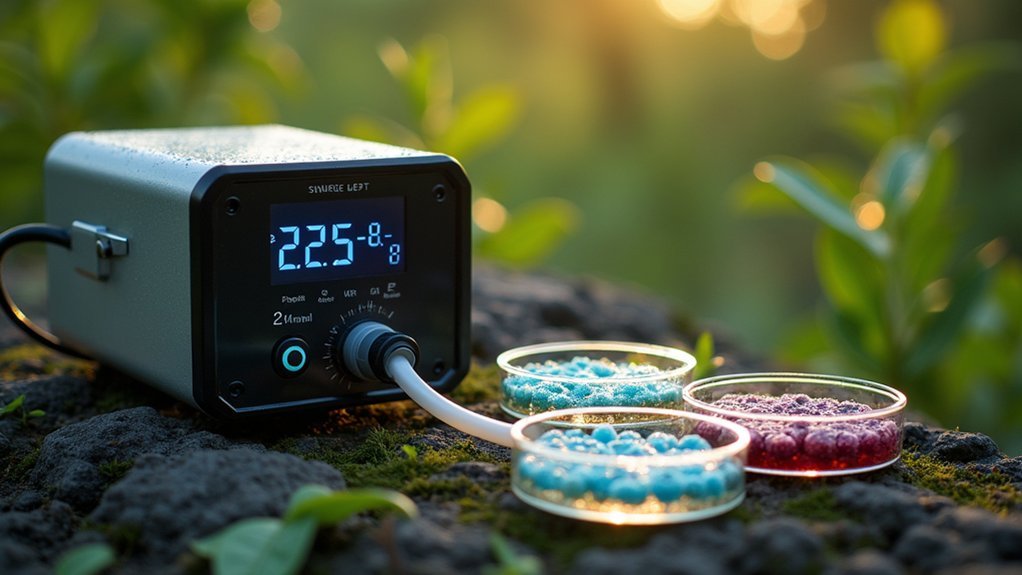
When conducting research beyond the confines of conventional laboratories, portable temperature control systems become essential tools for maintaining cellular viability during time-lapse imaging.
You’ll find devices like the ThermoClamp® Inline Heater offering precise regulation from ambient to 65°C, while the BubbleStop™ Syringe Heater pre-warms solutions to prevent bubble formation during field research.
- The Delta T® Culture Systems provide ideal temperature environments specifically designed for live-cell microscopy with high-numeric aperture disposable culture dishes.
- FCS Closed Chamber Systems enable micro-observation with thermal control and perfusion capabilities in remote settings.
- VAHEAT devices deliver ±0.1°C precision in the field of view, protecting optical components.
- These portable cell incubator alternatives guarantee consistent experimental conditions regardless of your research location.
Multi-Well Format Controllers for Parallel Time-Lapse Experiments
Moving from field applications to laboratory throughput capabilities, multi-well format controllers represent a significant advancement in time-lapse imaging technology.
Systems like the EVOS® Onstage Incubator allow you to simultaneously image multiple samples while maintaining ideal temperature, humidity, and gas levels across all wells.
These controllers support 24-well plates on inverted microscope stages, enabling parallel experiments without sacrificing cell viability during extended imaging sessions.
You’ll benefit from high-precision temperature control with ±0.1°C tolerance, essential for maintaining physiological conditions throughout multi-day studies.
For specialized live cell microscopy needs, the Delta T® Culture Systems offer high-numeric aperture compatibility with precise temperature control in disposable culture dishes.
With programmable gas gradients and automated sensing modes, you can guarantee consistent experimental conditions critical for reliable time-lapse data collection.
Frequently Asked Questions
How Long Does Calibration Typically Take for New Temperature Controllers?
Calibration for your new temperature controllers normally takes 15-30 minutes. You’ll need to run test cycles and adjust settings until you’re getting stable, accurate readings. Don’t rush this important setup step.
Can Temperature Controllers Interface With Older Microscope Models?
Yes, temperature controllers can interface with older microscope models. You’ll need the right adapters or mounting hardware. Many manufacturers offer retrofit solutions that connect to various microscope generations through universal mounting systems.
What Power Backup Options Exist for Uninterrupted Time-Lapse Imaging?
You’ll need UPS systems for short outages, battery backup units for longer periods, and generators for extended power losses. Don’t forget surge protectors to safeguard your imaging equipment during power fluctuations.
How Do Temperature Controllers Affect Camera Sensor Noise Levels?
Temperature controllers can reduce your camera’s sensor noise by maintaining stable conditions. When temperatures fluctuate, thermal noise increases. You’ll get cleaner images when controllers keep consistent temperatures during your time-lapse imaging experiments.
Are There Temperature Controllers Suitable for Hypoxic Imaging Conditions?
Yes, you’ll find specialized controllers like Tokai Hit STAGE TOP INCUBATOR and Okolab Bold Line that maintain stable hypoxic conditions while regulating temperature, essential for accurately observing cellular responses under low oxygen environments during imaging sessions.
In Summary
Your selection of temperature controller will greatly impact your time-lapse cell imaging results. Choose a system that’s right for your specific experimental needs, whether you’re conducting long-term studies, field research, or multi-well experiments. Remember, precision and stability aren’t just luxuries—they’re essential for generating reliable data. With today’s advanced options, you’ll find controllers offering both accuracy and convenience for your cell imaging work.





Leave a Reply